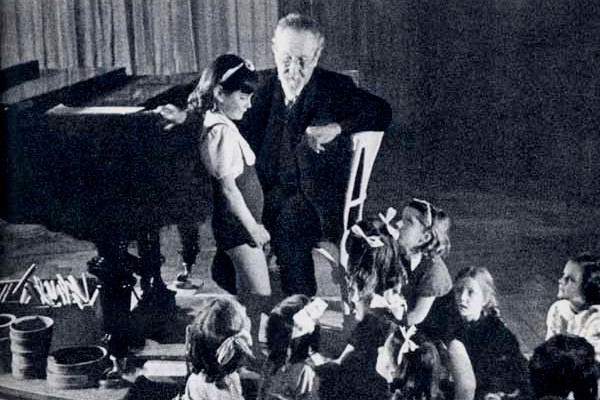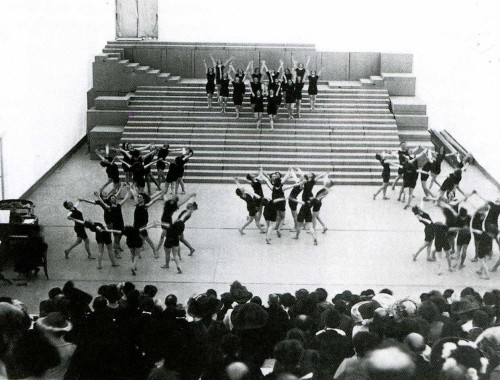If you’ve never heard of Dalcroze Eurhythmics — the pedagogy named for Emile Jaques-Dalcroze which uses movement & games to teach music concepts — you are not alone.

Due to its nature (it’s not very easy to put in words) and easy confusion about its name, almost any discussion of Dalcroze has to begin with what it is not. It is not the Eurhythmy of Rudolf Steiner, though both involve group movement. It is not the band The Eurythmics of Annie Lennox, though Lennox studied Dalcroze Eurhythmics at the Royal College of Music and named her band in honor of this. Dalcroze is of no relation to Delsarte the acting theorist and teacher, though he attended classes in the Delsarte method when living in Paris.* He has no connection to Delacroix the famous French romantic painter, though Dalcroze’s own sketches of movements frequently adorned his publications.
Even to those who do know the name and don’t confuse it with any of its homophones or near homophones, Dalcroze Eurhythmics frequently brings to mind a host of strange images with no clear definition: Classes of children in unitards dancing around the room to music, conducting comically large beat patterns with their arms, while stepping the strangest rhythms with their feet. But Dalcroze is not dance.
It is sometimes shrouded in a cult-like image. Dalcroze students and teachers are referred to as “Dalcrozians” or “Dalcroze-people,” and it has frequently been observed that the lines between music and life are entirely blurred for these people.
Of observations by “outsiders,” the best may be this fond caricature from Irish playwright George Bernard Shaw, who recorded his impressions of a class taught by Emile Jaques-Dalcroze:
I know the work that is being done by Miss Mason and the Dottoressa Montessori or, best of all as I think, the Eurythmics School of Jaques Dalcroze at Hellerau near Dresden. Jaques Dalcroze, like Plato, believes in saturating his pupils with music. They walk to music, play to music, work to music, obey drill commands that would bewilder a guardsman to music, think to music, live to music, get so clearheaded about music that they can move their several limbs each in a different metre until they become complicated living magazines of cross rhythms, and, what is more, make music for others to do all these things to. Stranger still, though Jaques Dalcroze, like all these great teachers, is the completest of tyrants, knowing what is right and that he must and will have the lesson just so or else break his heart (not somebody else’s, observe), yet his school is so fascinating that every woman who sees it exclaims “Oh, why was I not taught like this!” and elderly gentlemen excitedly enrol themselves as students and distract classes of infants by their desperate endeavors to beat two in a bar with one hand and three with the other, and start off on earnest walks round the room, taking two steps backward whenever Monsieur Dalcroze calls out “Hop!” Oh yes: I know all about these wonderful schools that you cannot keep children or even adults out of, and these teachers whom their pupils not only obey without coercion, but adore.
— George Bernard Shaw, Treatise on Parents and Children
Shaw, in fact, clearly captured the main goals of an education in Eurhythmics.
The Swiss composer and organist Frank Martin, a student of Dalcroze’s, in a talk on Eurhythmics from 1953, put it a bit more succinctly. Dalcroze Eurhythmics, he said:
…puts into play simultaneously the main activities of our being. First attention: you must not let anything slide of the music which you are hearing and recording instantaneously; then intelligence, for you must understand and analyze what you’ve heard; then sensitivity, you must feel the music you’ve heard, let yourself be penetrated by the movement of the music; and finally the body puts it in action, and, by its more or less adept movements to the music proves that you’ve been attentive, heard and understood, and been sensitive as well. … It is in this simultaneous and constant correspondence of the work of the spirit and of the body that you will find the release and joy which comes without fail from a good lesson in Eurhythmics.
— Frank Martin, 1953 (Trans. Jack Stevenson)
It’s rare that the explanations of Dalcrozians themselves get this close to the deep-seated goals of the method. This corporal sensitivity and awareness to music becomes so engrained that we frequently see only the pragmatic side. Rhythm is most easily taught to the full body — we take steps in a steady rhythm, skip in compound meter. Teaching music and rhythm through these life rhythms is natural and the quickest way. But in doing so, in constantly connecting movement to music and music to life, we hope to teach our students to hear music in every motion of their bodies, to feel and be moved by every musical sound they hear.
Emile Jaques-Dalcroze, the creator of Eurhythmics, was born in Vienna in 1865, but lived the majority of his life in Geneva. His mother was a Pestalozzi-trained teacher, and Dalcroze experienced these principles in his own education. Pestalozzi believed:
- Students should learn by direct experience. Never teach by words when the child can see/hear/or touch for themself.
- Teach through activity — the child acts and makes mistakes for himself, corrects themself, and learns through play.
- No books, at first, anyway. Concrete experience must come before abstract knowledge.
Dalcroze studied piano from age six, wrote his first opera at 16, and went off to Paris to study acting and composition. He attended classes in the Delsarte method; Delsarte had believed that true and believable acting came from an understanding of affective physical motion and gesture. He spent two years in Vienna, studying composition with Bruckner. He returned to Paris to study theory and composition with Matthis Lussy, whose theory of expressive performance was rooted in the study of rhythm and form. He worked for several years as a chorus master at an opera house in Algiers, and is said to have been fascinated by the mixed-meters and polyrhythms of the indigenous North-African music.
In 1892, Dalcroze took up a professorship in Solfege at the Geneva Conservatory. There he found that his students had only an intellectual understanding of music. Students with enormous technical skill varied wildly in their tempi and rarely showed expressivity in their performance. In solfege exercises students barely sang the notes. Dalcroze, informed certainly by his work with Lussy, his exposure to Delsarte, and his own Pestalozzi education, began experimenting with movement as a way to teach solfege, rhythm, and nuance. The first classes in this new method took place during the 1903/04 school year. The method developed and progressed rapidly, and by its first major public demonstration in 1906, very much resembled the method as we know it today.
Students pursued classes in three main areas. In Eurhythmics (or simply “Rhythmics”) students responded to music in motion, developing the sensitivity, coordination, and attention that Shaw and Martin described. In Solfege, students learned to translate the notes and harmonies they heard to the page and vice versa — always with the goal of developing sensitivity to the pulls of harmony and the harmonic implications of melody. Finally, in Improvisation, students learned to speak the musical language. They improvised music to match other students’ movements and played music for the various Eurhythmics games. One early student wrote that each morning, Dalcroze would carry the same musical topic through all three classes, so that by the end of three hours the students felt it in their bodies, could see it on the page, and could create their own music for the topic.
As the apocryphal tale goes, about this time, Dalcroze started to get in trouble with the administration at the Geneva Conservatory. The students’ daily clothing, he found, was inhibiting their ability to move expressively. When he requested a large space with dressing rooms — to allow the students to don tunics before class — the administration decided this was quite enough. Such skimpy and loose fitting clothing did not befit proper music students. Dalcroze left to found his own school.

In reality, when Dalcroze resigned he was named honorary professor at the Geneva Conservatory and awarded an honorary doctorate from the University of Geneva. What drew him away was industrialist Wolf Dohrn’s offer to build a new school with state-of-the art facilities for Dalcroze at Hellerau, outside of Dresden.
The buildings were built exactly to his specifications. Every Eurhythmics classroom featured a moveable set of stairs — movement games at an advanced level were conducted while going up and down these.

The theatre was state-of-the art, and the school’s productions were so renowned that actors from the Moscow Art Theatre (of Stanislavsky fame) were sent to observe them. From 1909 until the outbreak of World War I the institute was in operation. In 1914, Dalcroze returned to Geneva, and founded the Institut Jaques-Dalcroze, where he taught until his death in 1950. The Institut continues to be the only institution to give out the highest level of Dalcroze Certification, the Diplome Jaques-Dalcroze.
Dalcroze Eurhythmics is alive and well today. Students at many conservatories around the country take classes in it as part of their education. At the Cleveland Institute of Music and Carnegie Mellon University School of Music it is required for all students. Children’s classes taught by Dalcroze Certified teachers are available in many areas. Dalcroze’s influence is clear in the Orff approach to music pedagogy, which borrows heavily from Dalcroze’s movement and rhythm games. Interested teachers can find dozens of books on the Dalcroze method, or pursue certification through university study or at summer institutes.
Moreover, the basic principles of the method are continually recognized as solid by cognitive scientists. It is now generally accepted that children learn through play, that experience should come before abstract learning, and that kinesthetic learning plays a crucial role in cognitive development.
Though we are now more than one hundred years past the creation of Eurhythmics, the ideas behind it remain fresh and new. Students who are drawn to the method today come to understand, as their teacher’s teachers did, exactly what Dalcroze meant when he said, “C’est vous, la musique:” You are the music.
* Irwin Spector’s biography of Dalcroze claims that he attended classes with Delsarte himself. However, given that Delsarte died when Dalcroze was only six years old, this seems fairly unlikely.
